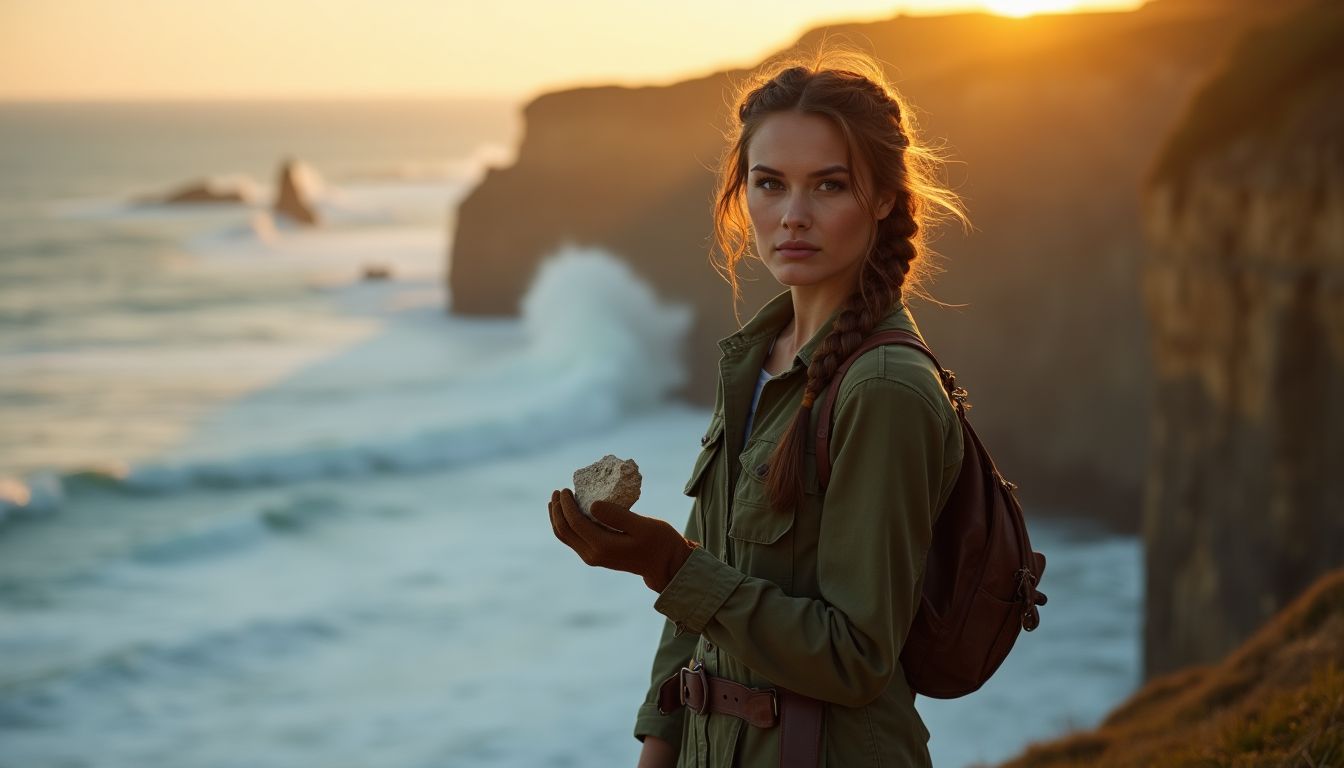The Huntress of Cliffs
The dawn sun haloed the jagged cliffs of East Sussex, painting the sedimentary layers with streaks of amber and gold. The air smelled faintly of salt and earth, a mix that clung to the skin, and the waves below crashed rhythmically, their cadence as ancient as the fossils tucked in the cliff’s embrace. Among whispers of seafoam and seagull cries, a lone figure stood, her silhouette equal parts determination and grace.
Louise "Lou" Marston was no ordinary fossil hunter. At thirty-seven, she carried an aura of both rugged resilience and quiet intensity. Her honey-brown hair, darkened by the misty air, was tied back into a loose braid, strands escaping to frame a face weathered from years of under-the-sky pursuits. High cheekbones and piercing hazel eyes gave her an almost predatory look, but her hands — calloused and strong — betrayed the gentle care with which she unearthed history.
Dressed in practical olive-green cargo pants tucked into well-worn boots, and a lightweight field jacket peppered with patches and pockets, she practically embodied the discipline she deeply loved. A leather satchel, full of field tools, hung across her shoulder, and on her wrist, a makeshift bracelet of ammonite fossils she’d collected over the years jingled softly as she moved. She had been coming here since she was ten, long before she ever thought to make this place her life’s calling. Fossil hunting was her heritage — her grandmother’s stories of discoveries had woven this into her marrow.
A Shard of the Past
Lou steadied her breath as she crouched near a precariously weathered section of the cliff. Her gloved hand sifted through chunks of loose sediment, her composition a mix of patient scrutiny and primal thrill. Then she saw it — faint and unassuming — a texture that didn’t belong amidst the surrounding rock.
It was a bone fragment no larger than her palm, peeking defiantly through layers of time. Lou’s lips curled into a half-smile, her heart hammering with a mixture of excitement and respect. She carefully brushed away the sediment, exposing more of the shard’s surface. Its edges bore the telltale signs of predatory teeth marks — and something deeper, more unusual. A faint ridge. A shape she didn’t expect to see, not here, not in this layer of geological history.
It was unlike anything she’d found before. In a world ruled by plesiosaurs and the lumbering iguanodonts, predatory dinosaurs were scarce here. Whatever Lou had stumbled upon, it was something old, something powerful, and something ferocious.
As the hours passed, Lou extracted more fragments and pieced together the faint story buried within the cliff face. She photographed, jotted notes, and even chuckled aloud to herself — the giddiness she tried to suppress bubbling over. "You," she said softly to the fossil, "aren’t supposed to be here."
Unfolding a Carnivorous Legacy
By midday, Lou had carried her trove back to her Land Rover parked precariously on the clifftop perch. Her workstation in the back was a shrine to her obsession — labeled tools glinted in their compartments next to preserved fossils, insulated observation boxes, and a double thermos of coffee. Lovingly, she laid her finds on the table and studied them under the portable lab lamp.
“A cousin to the Rex family, perhaps?” she murmured to no one, the words heavy with awe. The ridge on the bone suggested features not commonly seen among the theropods known to this region. It had a bulk and density that betrayed a beast of significant size — likely five meters long, likely built for tearing flesh. Yet it was lean, more refined than the prehistoric bruisers typically found in these parts. A creature built for killing with grace, like a ghost prowling the prehistoric haze of a Cretaceous forest.
As dusk rolled in, an email came through on her satellite-connected laptop. It was from Dr. Ahmed Jamal, her colleague at the Royal Museum of Paleontology. She attached photos of her discovery and followed it up with a single line in her message: “I think I’ve found something that rewrites the carnivorous playbook for Early Cretaceous Britain.”
Hours later, a single reply came: “Lou… This might be bigger than you think. I need you to come to London immediately.”
The Shadows That Lurk
The excitement ran through her veins, stronger than caffeine. However, Lou knew better than to let her guard down. As she loaded her discoveries into antique wooden boxes lined with protective foam, she caught movement in the corner of her eye. A shadow slinked across the coastal ridge behind her. It could have been her imagination, the play of moonlight against the grass, but instinct made her pause.
Lou froze, her breath caught halfway in her chest. She scanned the area but found nothing — only the whispering cliffs and the darkened sky. She shook her head and laughed softly. “Don’t start seeing ghosts now, Marston.”
But her grandmother's whispered warnings came unbidden to her mind. “When you start digging into the past, you’ll find not all of it rests peacefully.”
London’s Secrets
The next week saw Lou standing before an audience of renowned paleontologists. Her discovery, named Regnorex britannicus (or the "British King of Predators"), was unveiled with dramatic flair. As images of its reconstructed skeleton lit the room, murmurs of astonishment and a few drawn breaths filled the hall.
“Truly remarkable,” Dr. Jamal declared, stepping to the podium. “This single discovery has reshaped our understanding of Cretaceous fauna in Europe. A predator of this ferocity deserves its title. My colleague, Louise Marston, has once again demonstrated why she is one of the best in the field.” Applause filled the room, but Lou couldn’t shake the feeling that something — or someone — was watching her.
Echoes and Whispers
Late that evening, as she walked the city streets alone, her satchel of fossil samples clutched tightly beneath her arm, footsteps followed her through the fog. She turned a corner and stopped abruptly, breathing hard. The footsteps stopped too. Her hazel eyes scanned the fog, her grip tightening on the strap of her bag.
If the Earth could hold ghosts in its embrace, she felt sure they now walked beside her — not out of anger, but curiosity. Her discovery had awakened something, both inside her and in the world beyond.
And perhaps, she thought grimly, not all whispers from the past should be heard.
Genre: Historical Fiction and Thriller
The Source...check out the great article that inspired this amazing short story: Amateur dinosaur hunter discovers evidence that T.Rex's close cousin roamed East Sussex 135 million years ago
Disclaimer: This article may contain affiliate links. If you click on these links and make a purchase, we may receive a commission at no additional cost to you. Our recommendations and reviews are always independent and objective, aiming to provide you with the best information and resources.
Get Exclusive Stories, Photos, Art & Offers - Subscribe Today!

























Post Comment
You must be logged in to post a comment.